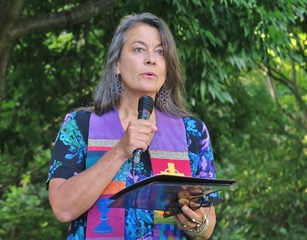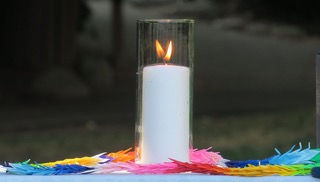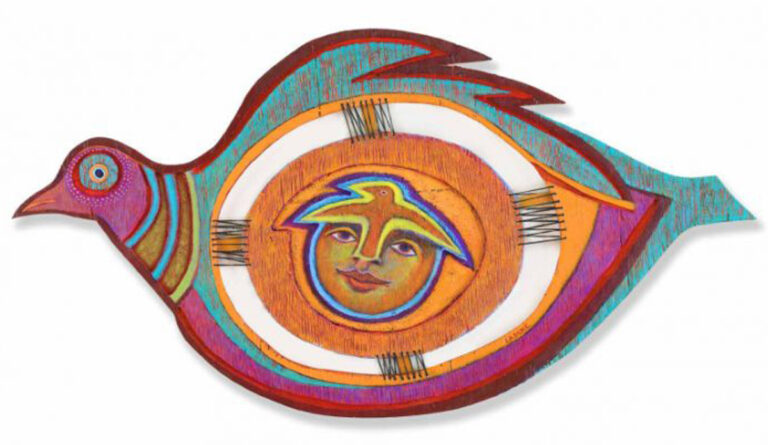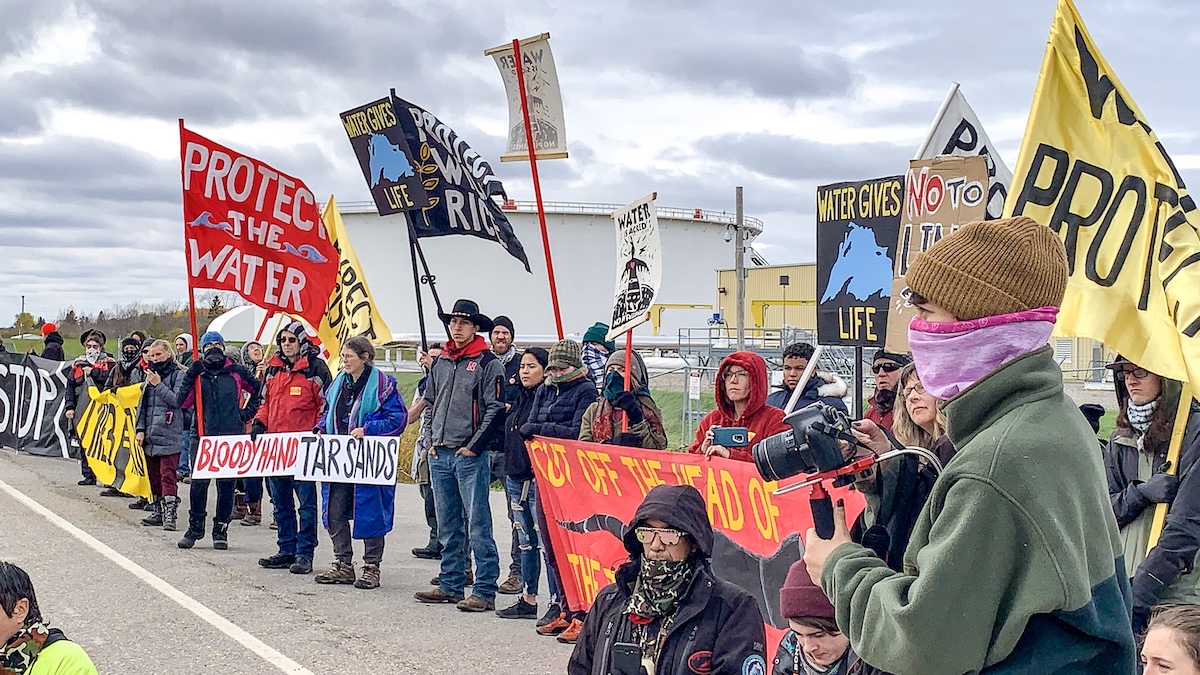2020 Rogue Valley Hiroshima-Nagasaki Vigil photos by Allen Hallmark
Ceremony Commemorating Hiroshima and Nagasaki

Let us acknowledge the indigenous people upon whose land we are gathered.: Takelma, Shasta and other tribal peoples lived here in sustainable ways for millenia. May we honor them and learn from them and their descendents.
I want to offer thanks to the people who make this event happen every year-and even in this unprecedented time. Special thanks to Mayor Jon Stromberg for his support through the years and to Betty LaDuke for her artwork honoring this day.
We have lost so many opportunities to gather in community and the moments when we can craft a sacred ritual together in the flesh have become rare.
So, I am grateful. I am sorry Masako is not here from Japan this summer to play her beautiful music. I am sorry that Hideko, our local hibakusha—survivor of the blast in Hiroshima—is not present (but you can listen to her excellent interview on Democracy Now! today).
 Let’s breathe deeply together in the quiet as we commemorate those killed and injured 75 years ago today in Hiroshima, and 3 days later in Nagasaki; let us also honor those negatively affected by the full cycle of the nuclear military industry: through testing, mining, processing, and manufacturing. And let us also be mindful of those most impacted by Covid throughout the world and those digging out of the rubble in Lebanon.
Let’s breathe deeply together in the quiet as we commemorate those killed and injured 75 years ago today in Hiroshima, and 3 days later in Nagasaki; let us also honor those negatively affected by the full cycle of the nuclear military industry: through testing, mining, processing, and manufacturing. And let us also be mindful of those most impacted by Covid throughout the world and those digging out of the rubble in Lebanon.
I draw on my Christian texts this morning rooted in the Hebrew tradition as I search for hope and purpose in this time when beyond the daily struggle to understand and to mitigate the dangers of the coronavirus pandemic, and reckon with the sins of our racism and settler colonialism, we bring our attention to the ongoing climate and nuclear threats.
And we hold on for dear life to our undying hope for co-creating a world committed to peace.
In the book of Isaiah we read: “How beautiful on the mountains are the feet of those who bring good news, who proclaim peace, who bring good tidings.”
In Ephesians in the New Testament of the bible we are invited to wear as shoes on our feet the eagerness to spread the message of peace.
 So, I want to take a minute to thank our feet for getting us here today and to all the places where we have journeyed for peace. If you are willing and able please stand and take two steps forward; one back; two to the right and two to the left. Look at them now and bless your feet. Honor their beauty-however unique they may be-and encourage them to keep showing up, and taking you forward in your commitment to bring a message of peace.
So, I want to take a minute to thank our feet for getting us here today and to all the places where we have journeyed for peace. If you are willing and able please stand and take two steps forward; one back; two to the right and two to the left. Look at them now and bless your feet. Honor their beauty-however unique they may be-and encourage them to keep showing up, and taking you forward in your commitment to bring a message of peace.
Back in January of this year the Doomsday Clock (of the Bulletin of Atomic Scientists) moved to 100 seconds to midnight–otherwise known as apocalypse–the closest to a nuclear accident the clock has indicated since 1953 in the early days of the cold war.
The statement from the Bulletin explains why:
“This situation—two major threats to human civilization, amplified by sophisticated, technology-propelled propaganda—would be serious enough if leaders around the world were focused on managing the danger and reducing the risk of catastrophe. Instead, over the last two years, we have seen influential leaders denigrate and discard the most effective methods for addressing complex threats—international agreements with strong verification regimes—in favor of their own narrow interests and domestic political gain.”
In his 2020 Mayor’s Declaration delivered earlier today in Hiroshima, Mayor Kazumi Matsui offered this cautionary tale as we face now the third existential risk of the coronavirus:
“When the 1918 flu pandemic attacked a century ago, it took tens of millions of lives and terrorized the world because nations fighting World War I were unable to meet the threat together. A subsequent upsurge in nationalism led to World War II and the atomic bombings.
We must never allow this painful past to repeat itself. Civil society must reject self-centered nationalism and unite against all threats.”
To this end the mayor emphasized the importance of our United Nations Treaties:
“…the Nuclear Non-Proliferation Treaty (NPT), which went into effect 50 years ago, and the Treaty on the Prohibition of Nuclear Weapons (TPNW) adopted three years…(both) critical to eliminating nuclear weapons.”
Mayor Matsui added: “Hiroshima considers it our duty to build in civil society a consensus that the people of the world must unite to achieve nuclear weapons abolition and lasting world peace.”
In 1977 Thomas Merton, the Trappist Monk wrote a meditational poem called Original Child Bomb, named for the word the Japanese used for the bomb dropped on Hiroshima. It has 41 sections describing the steps leading up to and following the events of August 6, 1945.
In 2004 Mary Becker made a multimedia documentary based on Merton’s work to “reveal the human scale of the use of nuclear weapons.” The film is mesmerizing, engaging for young people, and less than an hour long. As she updated it just recently for viewing on YouTube and in response to the Doomsday Clock report, she named the connections between Hiroshima and the Black Lives Matter protests currently under way.
Here are her words and I invite you to watch and share her film ORIGINAL CHILD BOMB on YouTube
“When the United States bombed Hiroshima and Nagasaki, in a real sense the people of those two cities were simply collateral damage. It was too bad that they died horrible deaths, but geopolitical power had to be maintained. The refusal to acknowledge that crime against Japanese men, women and children is a very deep shadow in the US psyche.
Just so, when African men and women were brought to the US colonies to labor as slaves in plantations, they were collateral damage. It was too bad that they were subjugated and seen as less than human. But the young nation needed goods and products in order for the economy to grow, and the bondage laborers assured that growth. The refusal to acknowledge and atone for the enslavement of Black Africans is a long-standing shadow in the US psyche.
There is another connection in the hundreds of thousands of homeless men, women and children in the US today. Too bad that they have to live on the streets, but they are only collateral damage to our consumer culture that worships high tech, high-rises, and high living, if only for a small percentage of our citizens. That is a very current shadow in the US psyche.
Shadows will not leave until we face them. It is way past time to face the shadow of racism. It is time now to face the shadow of homelessness, before it grows worse. And for the sake of human life on Earth, it is time to face the shadows of Hiroshima and Nagasaki.”
So, may this day serve as a reminder to do what we can do, meeting the threats together, facing our shadows with courage, letting our feet take us where we need to show up, and living in the hope that a better world is possible. As Arundhati Roy says: “Another world is not only possible, she is on her way. On a quiet day, I can hear her breathing.”
As a benediction I offer Mayor Matsui’s words and invite you to repeat them with me:
At this Peace Memorial Ceremony
marking 75 years since the bombing,
we offer heartfelt prayers
for the peaceful repose
of the souls of the atomic bomb victims.
Together with Nagasaki
and like-minded people around the world,
we pledge to do everything in our power
to abolish nuclear weapons
and open a path
to genuine and lasting world peace.


